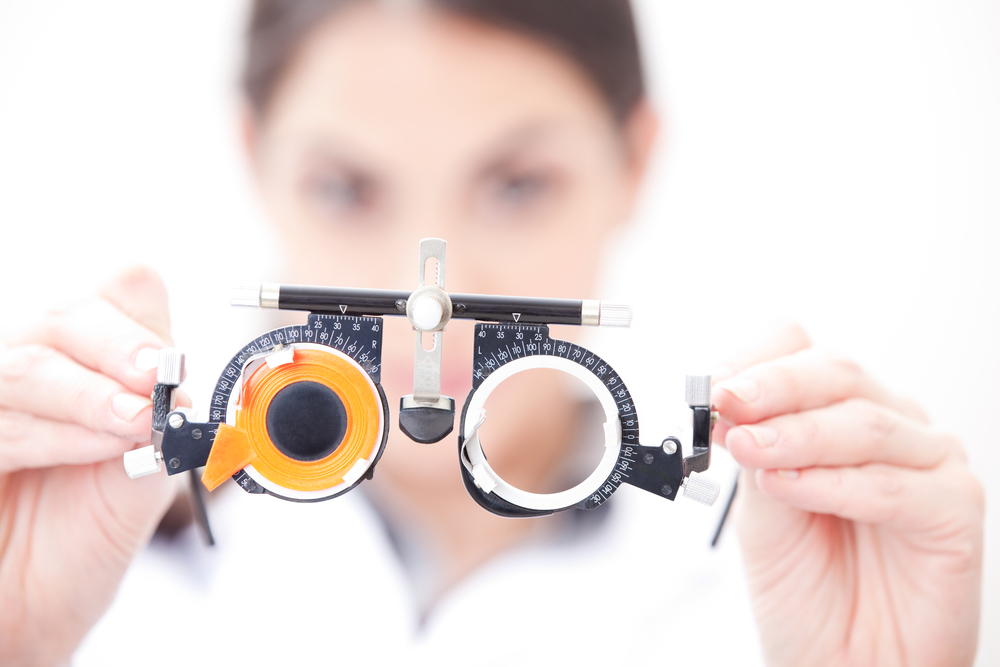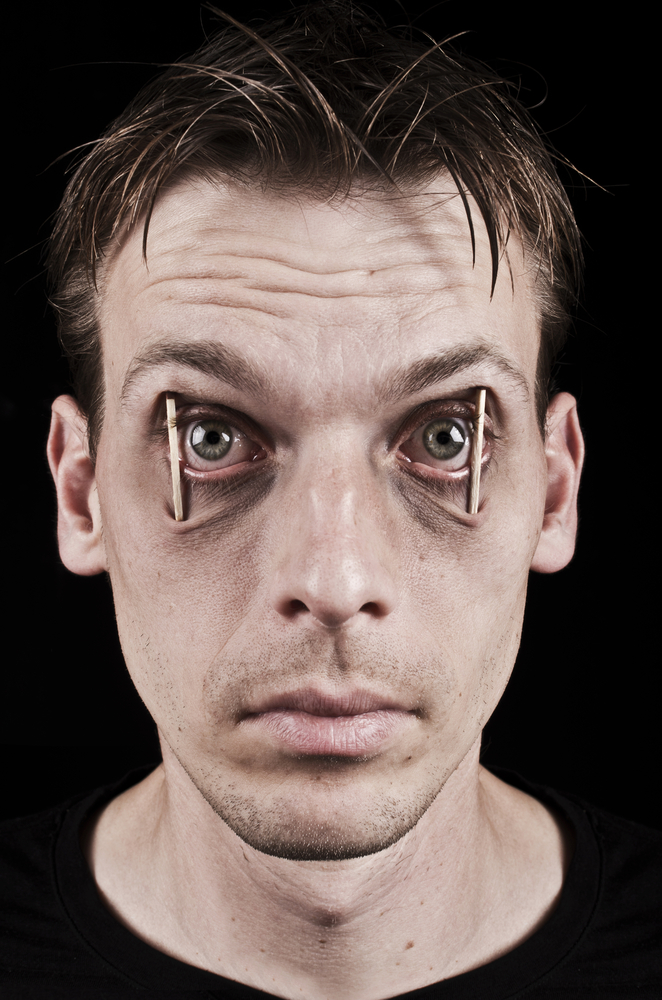
During the past decade, associations between sleep disorders and certain ophthalmologic disorders have been increasingly recognized. To review the literature on these important associations, we conducted a PubMed search using combinations of the following terms: sleep disorders, sleep apnea, circadian rhythm disorder, continuous positive airway pressure, eye disease, floppy eyelid syndrome, glaucoma, ischemic optic neuropathy, papilledema, nocturnal lagophthalmos, and vision loss.
We limited our search to articles published in English that involved human participants. All available dates were included. One of the most common sleep disorders, obstructive sleep apnea, has been associated with a variety of eye diseases, including glaucoma, nonarteritic anterior ischemic optic neuropathy, floppy eyelid syndrome, papilledema, and continuous positive airway pressure-associated eye complications. Nocturnal lagophthalmos manifests during sleep and is defined as the failure to fully close the eyelids at night. Finally, blindness is associated with increased risk of circadian rhythm disorders.
On the basis of the existing published literature, we discuss these rarely recognized associations, potential pathophysiologic mechanisms, and the effect these associations have on the clinical management of patients. The knowledge of these associations is important for the primary care physician, ophthalmologist, and sleep physician so that underlying sleep disorders or ophthalmologic disorders can be detected.
Sleep disorders and the eye.Waller EA(1), Bendel RE, Kaplan J.Mayo Clin Proc. 2008 Nov;83(11):1251-61.
Eye disorders associated with obstructive sleep apnoea.
West SD1, Turnbull C. Curr Opin Pulm Med. 2016 Nov;22(6):595-601.
PURPOSE OF REVIEW: Obstructive sleep apnoea (OSA) is increasing in prevalence due to rising obesity. Public awareness is also growing. Although OSA is a disorder primarily of the upper airway during sleep, its physiological impact on other parts of the body is now well recognized. There is increasing interest in the association of OSA with various eye disorders. Work in this field has been directed predominantly to OSA prevalence and association studies, but some authors have tried to elucidate the effect of OSA therapies on eye diseases, including continuous positive airway pressure, upper airway surgery or bariatric surgery. This review discusses the publications in this area from the past year.
RECENT FINDINGS: The key ocular disorders featured in the studies and meta-analayses include glaucoma, floppy eyelid syndrome, nonarteritic ischaemic optic neuropathy, keratoconus, age-related macular degeneration and diabetic retinopathy. Associations with OSA were found with all these conditions, but aspects of the studies still leave gaps in our knowledge.
SUMMARY: This review highlights the need for ophthalmologists to consider OSA in their patients and also makes recommendations for future research studies, especially whether therapies for OSA can be effective for ocular disorders also.
The effect of nocturnal CPAP therapy on the intraocular pressure of patients with sleep apnea syndrome.
Cohen Y(1), Ben-Mair E(2), Rosenzweig E(2), Shechter-Amir D(2), Solomon AS(3). Graefes Arch Clin Exp Ophthalmol. 2015 Dec;253(12):2263-71
PURPOSE: Few studies have documented that nocturnal continuous positive airway pressure (CPAP) therapy is associated with an increase in intraocular pressure (IOP) in patients with severe obstructive sleep apnea syndrome (OSAS). We re-examined the effect of CPAP therapy on the IOP of OSAS patients.
METHODS: The IOP of two different groups of newly diagnosed OSAS patients was compared at their first sleep lab exam without CPAP treatment (non-CPAP treated group; n = 20) and at the second sleep lab exam with CPAP treatment (CPAP treated group; n = 31). The sleep lab exam (sleep period: from 11:00 p.m. until 6:00 a.m.) included IOP measurements, a complete ophthalmologic exam, and nocturnal hemodynamic recordings. The IOP was measured serially using rebound tonometer (IOP; ICARE® PRO) performed while in sitting and supine positions before, during, and after the sleep period. We compared the difference in IOP of CPAP and non-CPAP groups.
RESULTS: The mean IOP of the CPAP and non-CPAP groups measured in sitting position before the sleep period was 13.33 ± 2.04 mmHg and 14.02 ± 2.44 mmHg, respectively (p = 0.9). Assuming a supine position for 1 minute significantly increased the IOP by 1.93 mmHg and 2.13 mmHg for both the non-CPAP and CPAP groups (paired t-test; p = 0.02, p = 0.001 respectively), but this IOP rise showed no difference between the two groups. The IOP increased significantly further after 7 hours of sleep in the supine position, and the mean IOP of the CPAP and non-CPAP groups was 19.2 ± 5.68 mmHg and 19.69 ± 5.61 mmHg respectively (independent t-test; p = 0.74). The rise in IOP for both groups was not correlated with any hemodynamic parameters. Three OSAS patients with glaucoma treated with CPAP had mean IOP of 23.75 mmHg after 7 hours of sleep.
CONCLUSIONS: OSAS patients have a significant rise in IOP during the sleep period when comparing measurements before and after the sleep period; however, CPAP therapy did not affect the measured IOP. The presented findings suggest that in terms of IOP, CPAP is safe for non-glaucomatous patients, but this may not hold true for glaucomatous patients.
Continuous positive airway pressure therapy is associated with an increase in intraocular pressure in obstructive sleep apnea.
Kiekens S(1), Veva De Groot, Coeckelbergh T, Tassignon MJ, van de Heyning P, Wilfried De Backer, Verbraecken J. Invest Ophthalmol Vis Sci. 2008 Mar;49(3):934-40.
PURPOSE: Several reports have demonstrated an association between glaucoma and obstructive sleep apnea (OSA), though the origin of this association remains unknown. In the present study, the influence of OSA and continuous positive airway pressure (CPAP) therapy on intraocular pressure (IOP) and ocular perfusion pressure (OPP) was examined.
METHODS: IOP, blood pressure, and pulse rate were measured every 2 hours during 24-hour sessions in 21 patients with newly diagnosed OSA. A first series of measurements was performed before CPAP therapy, and a second series was performed 1 month after the initiation of CPAP therapy. OPP was then calculated.
RESULTS: Baseline measurements showed a significant nycththemeral fluctuation in the average IOP, with the highest IOPs at night. After 1 month of CPAP therapy, the average IOP was significantly higher than baseline. The increase in overnight IOP was also significantly higher. A 24-hour IOP fluctuation of > or =8 mm Hg was found in 7 patients at baseline and in 12 patients during CPAP therapy. The mean difference between trough and peak IOP was 6.7 +/- 1.5 mm Hg at baseline and 9.0 +/- 2.0 mm Hg during CPAP therapy. Thirty minutes after CPAP cessation a significant decrease in IOP was recorded. There was a statistically significant decrease in mean OPP during CPAP therapy.
CONCLUSIONS: Patients with OSA demonstrated significant 24-hour IOP fluctuations, with the highest values at night. CPAP therapy causes an additional IOP increase, especially at night. Regular screening of visual fields and the optic disc is warranted for all patients with OSA, especially those treated with CPAP.
Anterior segment complications secondary to continuous positive airway pressure machine treatment in patients with obstructive sleep apnea.
Harrison W, Pence N, Kovacich S. Indiana University School of Optometry, Cornea and Contact Lens Research Clinic, Bloomington, Indiana, USA. Optometry. 2007 Jul;78(7):352-5.
BACKGROUND: Obstructive sleep apnea (OSA) is a disorder that, when left untreated, can have serious complications, mainly cardiovascular. OSA is commonly treated with a continuous positive airflow pressure (CPAP) machine. Patients using CPAPs routinely complain of dryness of the nose and eyes.
CASES: Case 1: A keratoconic woman, wearing gas-permeable lenses began therapy with a CPAP, and vascularized limbal keratitis (VLK) developed. She now wears soft lenses, compromising visual acuity, but preventing the VLK.
Case 2: A man with 20/20 visual acuity in the right eye (O.D.) and hand motion in the left eye (O.S.), presented with recurring corneal ulcers O.D. after starting treatment with a CPAP.
Case 3: A man with pellucid degeneration started using a CPAP, which increased his complaint of dryness with his lenses. He subsequently had 2 occurrences of bacterial conjunctivitis.
CONCLUSION: It is unclear if the complications seen in these cases come from leakage of air into the eyes causing drying, from bacteria trapped under the mask being forced up into the eyes, or from air passing from the nose into the eye via the nasolacrimal duct. In the care of these patients, being aware of complications, suggesting nighttime lubricants, and knowing the alternatives to CPAP could help maintain ocular health and successful lens wear.

Eyelid hyperlaxity and obstructive sleep apnea (O.S.A.) syndrome.
Robert PY1, Adenis JP, Tapie P, Melloni B. Eur J Ophthalmol. 1997 Jul-Sep;7(3):211-5.
PURPOSE: An association between the floppy eyelid syndrome and the obstructive sleep apnea syndrome (O.S.A.) has been reported. We studied eyelid tissue elasticity and other ophthalmologic findings in a large number of patients with sleep disorders.
MATERIAL AND METHODS: Sixty-nine patients with sleep disorders were evaluated. Two thirds were found to have O.S.A., and one third was treated at night by nasal continuous positive airway pressure(nasal C.P.A.P.). Slit lamp examination, eyelid measurements and Schirmer test were performed.
RESULTS: Eyelid hyperlaxity was increased in patients with O.S.A. The floppy eyelid syndrome (associated papillary conjunctivitis), however, was rare. Associated corneal lesions were rare, and most patients were asymptomatic. In some cases, ocular irritation was due to air leaks from nasal C.P.A.P. A significant proportion of patients required treatment for primary open angle glaucoma.
CONCLUSIONS: Our study of 69 patients found an association between O.S.A. and eyelid hyperlaxity.
Eyelid hyperlaxity and obstructive sleep apnea (O.S.A.) syndrome.
Glaucoma
Meta-Analysis of Association of Obstructive Sleep Apnea With Glaucoma.
Liu S, Lin Y, Liu X. Chongqing Key Laboratory of Ophthalmology, The First Affiliated Hospital of Chongqing, China J Glaucoma. 2016 Jan;25(1):1-7.
OBJECTIVES: Previous studies suggested that obstructive sleep apnea (OSA) was associated with glaucoma. However, data on this issue are controversial. This study aims to use meta-analysis to determine whether OSA is related to glaucoma.
MATERIALS AND METHODS: We searched PubMed, Embase, the Cochrane library, the Web of Science, and the Chinese BioMedical Literature Database disk databases up to November 20, 2014 for related literature. The association of OSA with glaucoma was assessed by odds ratio (OR) with 95% confidence interval (CI) as the effect size. Then subgroup analysis was performed according to area and glaucoma type.
RESULTS: Six primary studies (3 cohort study and 3 case-control studies) were included in this meta-analysis involving 2,288,701 participants. There was a significant association between OSA and glaucoma (adjusted-effect summary for case-control studies OR=2.46; 95% CI, 1.32-4.59, P=0.005) (adjusted-effect summary for cohort studies OR=1.43; 95% CI, 1.21-1.69, P=0.000). There was no significant publication bias.
CONCLUSION: OSA was a risk factor for glaucoma. A large number of studies is needed to explore the mechanisms that link OSA with glaucoma.
Prevalence of glaucoma in patients with moderate to severe OSA: ocular morbidity and outcomes in a 3 year follow-up study.
Hashim SP, Al Mansouri FA, Farouk M, Al Hashemi AA, Singh R. Ophthalmology Section, Hamad Medical Corporation, Doha, Qatar. Eye (Lond). 2014 Nov;28(11):1304-9. Erratum in Eye (Lond). 2014 Nov;28(11):1393.
PURPOSE: This study was conducted to investigate the prevalence and progressionof glaucoma in patients receiving treatment for obstructive sleep apnea (OSA). Wealso investigated whether there is an association between severity of OSA and theincidence of glaucoma.
METHODS: A total of 39 patients aged >30 years who had been diagnosed withmoderate and severe OSA in the sleep clinic at Hamad General Hospital wereassessed for the presence of glaucoma. The severity of OSA was graded as mild,moderate, or severe based on American Association of Sleep Medicine (AASM)criteria using the apnea hypopnea index. Before enrollment, all patientsunderwent a complete ophthalmic examination including serial visual field tests, optical coherence tomography (OCT) with fundus photographs, and pachymetry.Enrolled patients were followed up in the ophthalmology outpatient clinic andsleep clinic for a period of 3 years.
RESULTS: Examinations found that 8 (20.5%; 95% confidence interval (CI) 9.9-37%) of the 39 patients with OSA had glaucoma. Six (75%; 95% CI 36-96%) of thesepatients had normal-tension glaucoma (NTG) and two (25%; 95% CI 4.5-64.4%)patients had high-tension glaucoma. Among the 27 patients with severe OSA, 7(25.9%; 95% CI 8-34%) had glaucoma, and among 12 patients with moderate OSA, 1(8.3%; 95% CI 0.1-15%) had glaucoma. During the course of follow-up, two patientswho previously did not have glaucoma were reclassified as NTG and two patients with glaucoma deteriorated. A higher prevalence of glaucoma in the severe OSA group compared with the moderate OSA group was found, albeit a statistically significant difference could not be attained (P=0.4).
CONCLUSIONS: Our study showed that severe OSA is an important risk factor for developing glaucoma. Adequate treatment of OSA, along with optimal ophthalmiccare, resulted in better control of glaucoma.
Obstructive sleep apnoea syndrome in patients with primary open-angle glaucoma.
Balbay EG, Balbay O, Annakkaya AN, Suner KO, Yuksel H, Tunç M, Arbak P. Department of Chest Diseases, Faculty of Medicine, Düzce University, 81620 Düzce, Turkey. Hong Kong Med J. 2014 Oct;20(5):379-85.
OBJECTIVE: To investigate the prevalence of obstructive sleep apnoea syndrome in patients with primary open-angle glaucoma.
DESIGN: Case series.
SETTING: School of Medicine, Düzce University, Turkey.
PATIENTS: Twenty-one consecutive primary open-angle glaucoma patients (12 females and 9 males) who attended the out-patient clinic of the Department of Ophthalmology between July 2007 and February 2008 were included in this study. All patients underwent polysomnographic examination.
RESULTS: The prevalence of obstructive sleep apnoea syndrome was 33.3% inpatients with primary open-angle glaucoma; the severity of the condition was mild in 14.3% and moderate in 19.0% of the subjects. The age (P=0.047) and neck circumference (P=0.024) in patients with obstructive sleep apnoea syndrome were significantly greater than those without the syndrome. Triceps skinfold thickness in glaucomatous obstructive sleep apnoea syndrome patients reached near significance versus those without the syndrome (P=0.078). Snoring was observed in all glaucoma cases with obstructive sleep apnoea syndrome. The intra-ocular pressure of patients with primary open-angle glaucoma with obstructive sleep apnoea syndrome was significantly lower than those without obstructive sleep apnoea syndrome (P=0.006 and P=0.035 for the right and left eyes, respectively). There was no significant difference in the cup/disc ratio and visual acuity, except visual field defect, between primary open-angle glaucoma patients with and without obstructive sleep apnoea syndrome.
CONCLUSIONS: Although it does not provide evidence for a cause-effect relationship, high prevalence of obstructive sleep apnoea syndrome in patients with primary open-angle glaucoma in this study suggests the need to explore the long-term results of coincidence, relationship, and cross-interaction of these two common disorders.
Nasal CPAP during wakefulness increases intraocular pressure in glaucoma.
Alvarez-Sala R(1), García IT, García F, Moriche J, Prados C, Díaz S, Villasante C, Alvarez-Sala JL, Villamor J. Monaldi Arch Chest Dis. 1994 Dec;49(5):394-5.
Few important side-effects of nasal continuous positive airway pressure (nCPAP) have been reported. No increase of intraocular pressure (IOP) complicating this treatment has previously been described. The goal of our study was to analyse the influence of nCPAP on IOP. We evaluated 18 patients previously diagnosed as having glaucoma and 22 normal subjects. nCPAP was used during wakefulness, at +12 cmH2O for 15 min.
The results showed that nCPAP significantly increases IOP in patients with glaucoma (before nCPAP 20.3 +/- 6.3 mmHg) (mean +/- SEM); after nCPAP 22.3 +/- 5.7 mmHg. We believe that nCPAP might be relatively contraindicated in difficult to manage glaucoma patients, if these results are corroborated.

Obstructive sleep apnea patients having surgery are less associated with glaucoma.
Chen HY(1), Chang YC(2), Lin CC(3), Sung FC(4), Chen WC(5). J Ophthalmol. 2014;2014:838912. Epub 2014 Jul 24.
OBJECTIVE: To investigate if different treatment strategy of obstructive sleep apnea (OSA) was associated glaucoma risk in Taiwanese population.
METHODS: Population-based retrospective cohort study was conducted using data sourced from the Longitudinal Health Insurance Database 2000. We included 2528 OSA patients and randomly selected and matched 10112 subjects without OSA as the control cohort. The risk of glaucoma in OSA patients was investigated based on the managements of OSA (without treatment, with surgery, with continuous positive airway pressure (CPAP) treatment, and with multiple modalities).
The multivariable Cox regression was used to estimate hazard ratio (HR) after adjusting for sex, age, hypertension, diabetes, hyperlipidemia, and coronary artery disease. Results. The adjusted HR of glaucoma for OSA patients was 1.88 (95% CI: 1.46-2.42), compared with controls. For patients without treatment, the adjusted HR was 2.15 (95% CI: 1.60-2.88). For patients with treatments, the adjusted HRs of glaucoma were not significantly different from controls, except for those with CPAP (adjusted HR = 1.65, 95% CI = 1.09-2.49).
CONCLUSIONS: OSA is associated with an increased risk of glaucoma. However, surgery reduces slightly the glaucoma hazard for OSA patients.
Effects of Use of a Continuous Positive Airway Pressure Device on Glaucoma.
Ulusoy S(1), Erden M(2), Dinc ME(1), Yavuz N(3), Caglar E(4), Dalgic A(1), Erdogan C(5). Med Sci Monit. 2015 Nov 8;21:3415-9.
BACKGROUND: The aim of this study was to investigate the prevalence of glaucoma in obstructive sleep apnea syndrome (OSAS) and to determine the efficacy of the equipment used in the treatment of this disease.
MATERIAL AND METHODS: In this cross-sectional study, 38 patients with OSAS used the continuous positive airway pressure (CPAP) device (Group 1) and 32 patients with OSAS refused CPAP device (Group 2). Thirty-six patients did not have OSAS (Group 3).
RESULTS: Patient age, gender, height, weight, and neck circumference did not differ among groups (p>0.05); and the apnea-hypopnea index (AHI) and respiratory disturbance index (RDI) values did not differ between Groups 1 and 2 (p>0.05). Vision and pachymetric values did not differ among groups (p>0.05). The IOP was significantly higher in Group 2 than in Group 1 (p<0.05) but did not differ between Groups 1 and 3 (p>0.05). The fundus C/D ratio was significantly higher (p<0.05) in Group 2 than in the other groups but did not differ between Groups 1 and 3 (p>0.05). In Group 1, 2, and 3, 5.2%, 12.5%, and 0%, respectively, of patients had glaucoma.
CONCLUSIONS: OSAS should be considered a significant risk factor for glaucoma. Eye tests may help to identify individuals with undiagnosed OSAS, and such testing of patients with diagnosed OSAS may allow early detection of glaucoma and referral of such patients for CPAP therapy to prevent development of complications.
Normal tension glaucoma, sleep apnea syndrome and nasal continuous positive airway pressure therapy–case report with a review of literature.
Kremmer S(1), Selbach JM, Ayertey HD, Steuhl KP. Klin Monbl Augenheilkd. 2001 Apr;218(4):263-8.
BACKGROUND: In the pathogenesis of glaucoma, besides an elevated intraocular pressure (IOP), cardiovascular risk factors, such as arterial hypotension and hypertension, vasospasms, autoregulatory defects, atherosclerosis, and diabetes mellitus are of increasing importance, especially in normal tension glaucoma. Recently, there have been several reports of an additional risk factor: obstructive sleep apnea syndrome.
METHODS: Literature review (Medline) and case report.
RESULTS: The authors report on a 8 1/2 years follow-up of a 60-year-old patient with normal tension glaucoma. Despite successful pharmacological and surgical lowering of intraocular pressure a progressive glaucomatous damage with optic nerve atrophy and increasing visual field defects occurred. As a result of intensive investigations of possible cardiovascular risk factors, an obstructive sleep apnea syndrome was diagnosed. Since the beginning of therapy with nCPAP (nasal continuous positive airway pressure) more than 3 1/2 years ago, no further progression of glaucomatous optic nerve damage or visual field defects have been observed.
CONCLUSIONS: In clinical practice, obstructive sleep apnea syndrome often is underdiagnosed. In patients suffering from glaucoma and obstructive sleep apnea syndrome, intraocular pressure lowering therapy may not be enough, whereas an additional nCPAP-therapy potentially could prevent the beginning/progression of glaucomatous optic nerve damage.



